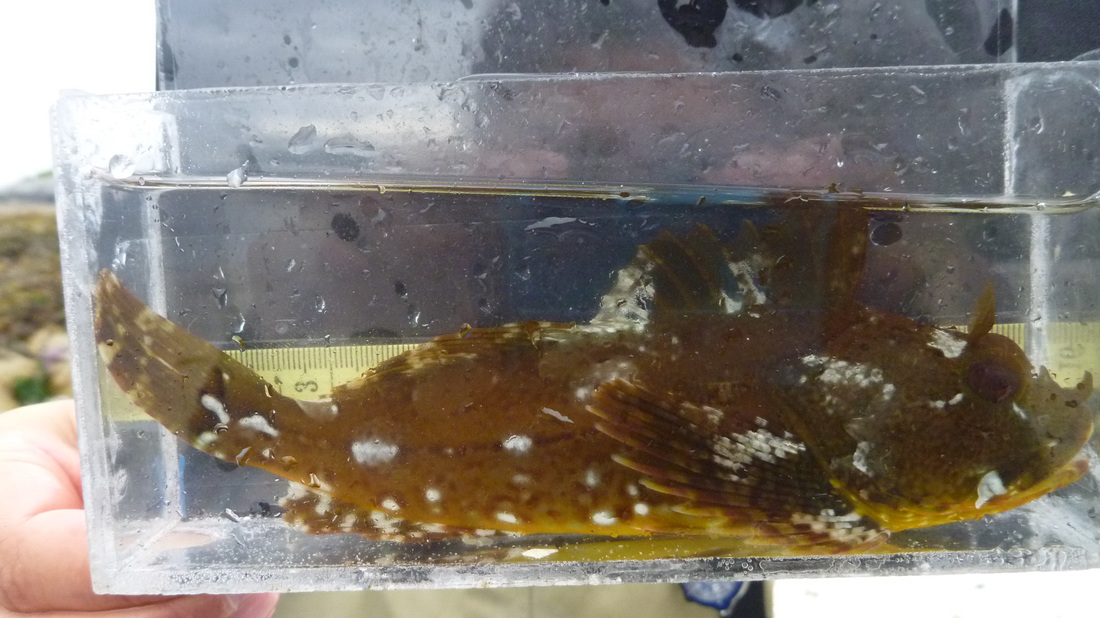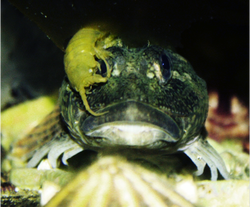Cabezon, marbled sculpin, giant sculpin • Scorpaenichthys marmoratus
{Scorpaenichthys = scorpion fish; marmoratus = marbled; cabezon = large head}
Left: photo by Angeleen Olson. Right: a kelp isopod (Idotea wosnesenskii) crawls over a cabezon. Photo by Yuhei Iida.
Identification
This large sculpin reaches a length of 1 m and weight of 14 kg (30 lbs). Often well camouflaged, the cabezon has a marbled colouring with light patches on a olive green, brown, or grey body. Its head bears three projections (cirri): a single flap-like cirrus at the tip of its snout, and a bushy cirrus over each eye. Its first dorsal fin is notched, and its scales are so deeply embedded that they initially appear absent.
Habitat & Range
The cabezon is often spotted sheltering among kelp around the rocky reefs it inhabits, from the intertidal to around 230 m. Its range extends from southern Alaska to northern Mexico. Young cabezons are often found in tidepools.
Human Uses
This species is a popular target for sport fishermen, particularly in California. Its is caught incidentally by commercial fishermen targeting coastal rockfish in California, Oregon, and Washington. See the Monterey Bay Seafood Watch recommendations for this species.
Intriguing Info
The male aggressively guards his green, mauve, or purple eggs, and will charge unsuspecting divers who get too close. Warning: these eggs are toxic! Once hatched the larvae drift offshore, and the small, silvery young return to nearshore waters while developing into adults.
iNaturalist
https://www.inaturalist.org/taxa/47638-Scorpaenichthys-marmoratus
This large sculpin reaches a length of 1 m and weight of 14 kg (30 lbs). Often well camouflaged, the cabezon has a marbled colouring with light patches on a olive green, brown, or grey body. Its head bears three projections (cirri): a single flap-like cirrus at the tip of its snout, and a bushy cirrus over each eye. Its first dorsal fin is notched, and its scales are so deeply embedded that they initially appear absent.
Habitat & Range
The cabezon is often spotted sheltering among kelp around the rocky reefs it inhabits, from the intertidal to around 230 m. Its range extends from southern Alaska to northern Mexico. Young cabezons are often found in tidepools.
Human Uses
This species is a popular target for sport fishermen, particularly in California. Its is caught incidentally by commercial fishermen targeting coastal rockfish in California, Oregon, and Washington. See the Monterey Bay Seafood Watch recommendations for this species.
Intriguing Info
The male aggressively guards his green, mauve, or purple eggs, and will charge unsuspecting divers who get too close. Warning: these eggs are toxic! Once hatched the larvae drift offshore, and the small, silvery young return to nearshore waters while developing into adults.
iNaturalist
https://www.inaturalist.org/taxa/47638-Scorpaenichthys-marmoratus
References
Cabezon. Monterey Bay Aquarium. Monterey Bay Aquarium Foundation. Acccessed 20/11/2014.
Cabezon, Wild. Monterey Bay Seafood Watch. Monterey Bay Aquarium Foundation. Accessed 20/11/2014.
Froese, R. and Luna, S.M. Scorpaenichthys marmoratus (Ayres, 1854). FishBase. Accessed 20/11/2014.
Harbo, R. M. (1999). Whelks to whales: Coastal marine life of the Pacific Northwest. Madeira Park, BC: Harbour Publishing. P. 212.
Lamb, A. and Edgell, P. Coastal Fishes of the Pacific Northwest. Revised. (2010). Madeira Park, BC: Harbour Publishing. Pp. 241-242.
Lamb, A., and Hanby, B. (2005). Marine Life of the Pacific Northwest [electronic version]. Madeira Park, BC: Harbour Publishing.
Authors and editors of page
Kelly Fretwell and Brian Starzomski (2014).
Cabezon. Monterey Bay Aquarium. Monterey Bay Aquarium Foundation. Acccessed 20/11/2014.
Cabezon, Wild. Monterey Bay Seafood Watch. Monterey Bay Aquarium Foundation. Accessed 20/11/2014.
Froese, R. and Luna, S.M. Scorpaenichthys marmoratus (Ayres, 1854). FishBase. Accessed 20/11/2014.
Harbo, R. M. (1999). Whelks to whales: Coastal marine life of the Pacific Northwest. Madeira Park, BC: Harbour Publishing. P. 212.
Lamb, A. and Edgell, P. Coastal Fishes of the Pacific Northwest. Revised. (2010). Madeira Park, BC: Harbour Publishing. Pp. 241-242.
Lamb, A., and Hanby, B. (2005). Marine Life of the Pacific Northwest [electronic version]. Madeira Park, BC: Harbour Publishing.
Authors and editors of page
Kelly Fretwell and Brian Starzomski (2014).






